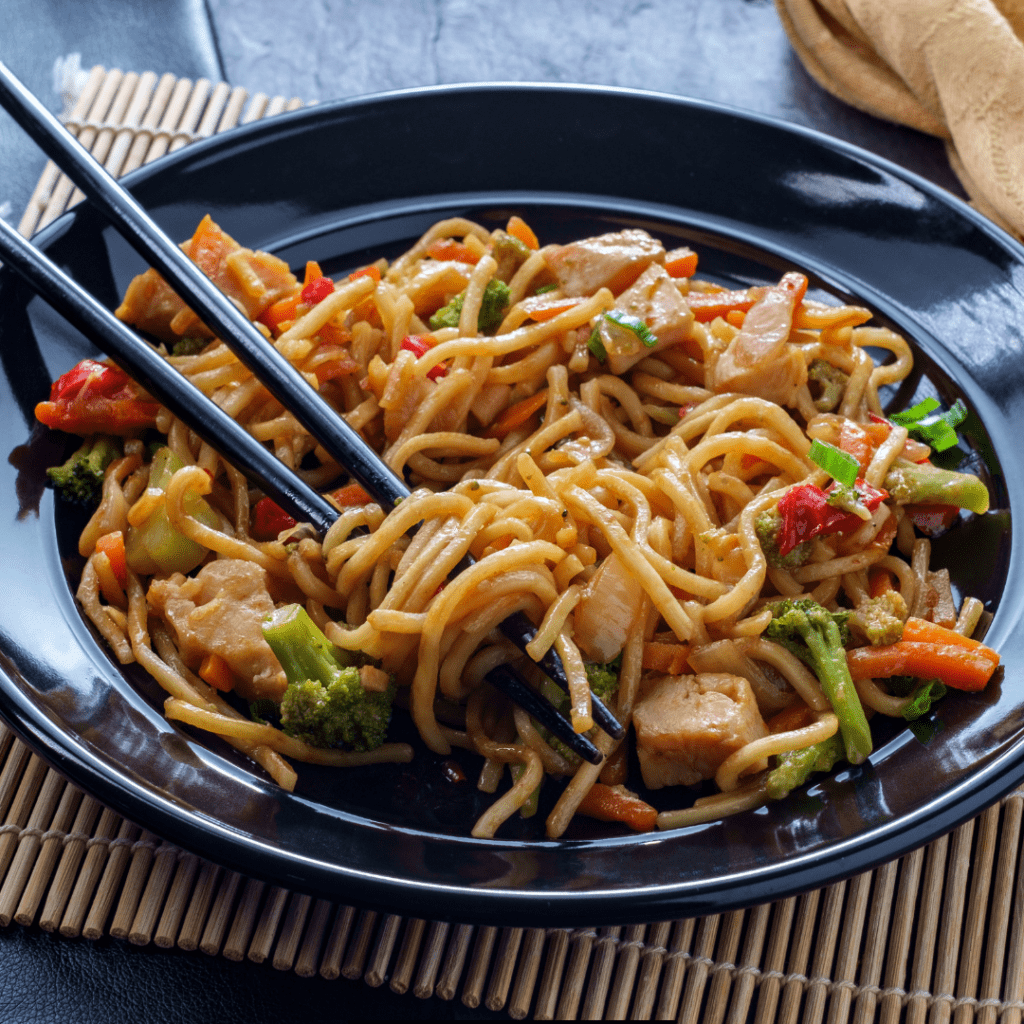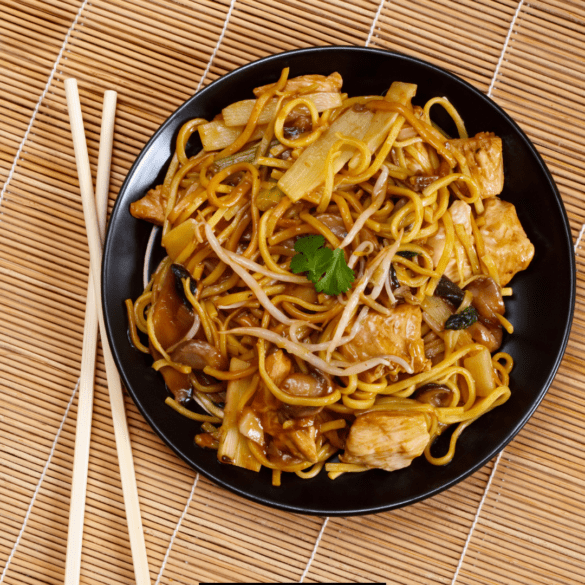On nights like these, when the thought of whipping up a complicated meal seems more daunting than comforting, I often find solace in the simplicity and delightful flavors of Sapporo Ichiban Chow Mein. This lovely dish, a cherished staple in my pantry, offers the ease of preparation we all crave on a weary evening and the rich, comforting taste that feels like a warm hug.
How to make Sapporo Ichiban Chow Mein
Sapporo Ichiban Chow Mein is a brand of instant noodle product that features stir-fried noodles. Originating from Japan, it typically comes with a seasoning packet that adds flavor to the dish. The noodles are often slightly thicker than traditional ramen, and the dish may include vegetables and protein options like chicken or shrimp.
Ingredients:
- A packet of Sapporo Ichiban Chow Mein.
- Sliced vegetables such as bell peppers, onions, cabbage, or carrots
- Protein of choice, like chicken, beef, tofu, or shrimp, cut into small pieces
- A scrambled egg
- Green onions and sesame seeds for garnish
- Extra seasonings like soy sauce, oyster sauce, or chili oil for an additional flavor kick
Instructions:
- Prepare the Ingredients: Start by chopping your vegetables and protein into bite-sized pieces. If you’re using egg, beat it lightly in a bowl.
- Cook the Noodles: Bring a pot of water to a boil. Add the Sapporo Ichiban Chow Mein noodles and cook for about 3 minutes until they are tender. Avoid over-cooking as they will continue to cook when stir-fried.
- Prepare the Protein and Vegetables: While the noodles are cooking, heat a tablespoon of oil in a large pan or wok over medium-high heat. Add your chosen protein and stir-fry until almost cooked through. Remove and set aside. In the same pan, add a bit more oil if necessary and sauté the vegetables until just tender.
- Scramble the Egg: Push the vegetables to the side of the pan and pour in the beaten egg, scrambling until it’s fully cooked.
- Combine Everything: Drain the noodles and add them to the pan with the vegetables and egg. Add the seasoning packet from the Sapporo Ichiban Chow Mein package and any additional sauces you like. If the dish seems dry, a splash of water can help distribute the seasonings evenly. Toss everything together, ensuring the noodles are well-coated with the sauce.
- Serve: Once everything is heated through and well combined, transfer the chow mein to a serving dish. Garnish with chopped green onions, sesame seeds, or any extra toppings you prefer.
Tips:
- Customizing the Flavor: Don’t hesitate to adjust the seasonings according to your taste preference. Adding a bit of oyster sauce can give a wonderful depth of flavor, while a few dashes of chili oil can provide a spicy kick.
- Vegetable Choices: Opt for vegetables that cook relatively quickly and complement the savory flavors of the chow mein. A mix of colors makes the dish visually appealing and ensures you get a variety of nutrients.
- Cooking the Protein: If using tofu as your protein, consider pressing it first to remove excess water. This will help it brown better in the pan and absorb more flavor from the sauces.
- Leftovers and Storage: Chow mein can be stored in an airtight container in the refrigerator for up to two days. To reheat, simply toss it in a pan over medium heat until warm.
What to serve with
Sapporo Ichiban Chow Mein can be a filling dish on its own, but pairing it with complementary sides and beverages can elevate your dining experience and turn a simple noodle dish into a complete meal.
Appetizers or Side Dishes:
- Spring Rolls or Egg Rolls: Crispy spring rolls or egg rolls make a great starter or side dish to accompany your chow mein. The crunch of the rolls contrasts nicely with the soft noodles.
- Steamed Dumplings or Potstickers: These are perfect bite-size nibbles that add a hearty element to your meal. Fill them with vegetables, pork, chicken, or shrimp for a lovely range of flavors.
- Edamame: Lightly salted and steamed soybeans (edamame) provide a simple and healthy side that adds a nice pop of color and is rich in protein.
- Wonton Soup: If you’re in the mood for comfort food, a warm bowl of wonton soup before the main course can be soothing and enhance the flavors of your main dish.
- Stir-Fried Vegetables: A side of stir-fried vegetables such as bok choy, broccoli, or snow peas can add freshness and balance to the meal while boosting your veggie intake.
- Asian Coleslaw: A slaw made from shredded cabbage, carrots, and a tangy Asian dressing can provide a crunchy and refreshing counterpoint to the savory noodles.
Proteins:
- Sweet and Sour Chicken or Pork: A sweet and sour chicken or pork combination of sweet, tangy, and fruity flavors complements the umami savory taste of chow mein noodles.
- Teriyaki Stir Fry: Teriyaki sauce glazed over your choice of protein with some sesame seeds sprinkled on top is rich in flavor and pairs wonderfully with the chow mein.
- Tofu: For vegetarians, braised or fried tofu can add a great protein boost and add texture to the meal.
Salads:
- Asian-Inspired Salad: A light salad made with mixed greens, mandarin oranges, slivered almonds, and a sesame ginger dressing can provide a refreshing contrast.
- Cucumber Salad: Thinly sliced cucumbers marinated with vinegar, sugar, and sesame seeds create a cool and crisp side dish.
Beverages:
- Green Tea: Green tea or jasmine tea can aid digestion and offer a refreshing palate cleanser between bites.
- Beer: A light lager or an Asian beer like Sapporo or Tsingtao can complement the salty and robust flavors of the chow mein.
- Wine: A Riesling or Gewürztraminer, which tends to have a sweet note, can balance the saltiness of the soy sauce in the chow mein.
Desserts:
- Mochi Ice Cream: Finish off your meal with mochi ice cream, a Japanese rice cake filled with ice cream that comes in various flavors.
- Fortune Cookies: While not traditionally Chinese, they are a fun and light way to end a meal at many Asian-inspired restaurants.
- Fruit Platter: A simple, healthy way to end the meal could be a platter of fresh fruit like pineapple, lychee, or orange slices.
Ingredients Substitutes

Making Sapporo Ichiban Chow Mein at home allows you to customize it according to the availability of ingredients, dietary preferences, and taste. While the original pack comes with its pre-made seasoning and noodle cake, making a version from scratch or amending the pre-packaged version with substitutes can yield delicious results.
Noodles:
Original Ingredient: Pre-packaged Sapporo Ichiban Chow Mein noodles.
Substitutes: Fresh yakisoba noodles, dried or fresh ramen noodles, lo mein noodles, or even spaghetti in a pinch. The key is to look for noodles with a similar thick and chewy texture.
Protein:
Original Ingredient: The package doesn’t usually include meat, so you’d typically add your desired protein.
Substitutes:
- Use tofu, seitan, or Quorn as a vegetarian option for chicken.
- For pork, consider turkey or chicken for a lighter option or jackfruit for a vegan alternative.
- For seafood options, imitating crab or canned tuna can substitute fresh seafood in a more budget-friendly version.
Vegetables:
Original Ingredient: Cabbage, carrots, and onion are commonly added to chow mein.
Substitutes:
- Cabbage can be replaced with brussel sprouts thinly sliced, or bok choy for a different texture.
- Try sweet bell peppers or snow peas for a similar crunch to carrots.
- Leeks or shallots can stand in for onions, offering a milder flavor.
Seasoning and Sauce:
Original Ingredient: The seasoning packet in Sapporo Ichiban Chow Mein provides a distinct flavor.
- Substitutes for Soy Sauce: Tamari for a gluten-free option or coconut aminos for a lower sodium and soy-free choice.
- Oyster Sauce Replacement: Use hoisin sauce or a mix of soy sauce with a touch of sugar as a vegetarian substitute.
- Sesame Oil Alternative: If you don’t have sesame oil, use a neutral oil like canola or vegetable oil and add a bit of extra toasted sesame seeds for flavor.
- Substitute for msg flavor enhancer: Nutritional yeast can offer a similar umami quality without using MSG.
To Enhance Umami (If avoiding the seasoning packet):
- Mushrooms: Finely chopped mushrooms, especially shiitake, can add a depth of flavor.
- Seaweed: A small amount of finely chopped nori or kelp can enhance the umami without overpowering the dish.
- Tomato Paste: A little can add richness and depth, mimicking some of the complex flavors in the seasoning packet.
Final Thoughts
When choosing what to serve with Sapporo Ichiban Chow Mein, choose a balance of flavors, textures, and food groups. Side dishes that offer crisp, light, and refreshing notes can help round out the meal, while diverse beverage options cater to different tastes and either cleanse the palate or complement the meal’s flavors.
More Pasta Recipes:

Ingredients
- A packet of Sapporo Ichiban Chow Mein.
- Sliced vegetables such as bell peppers, onions, cabbage, or carrots
- Protein of choice, like chicken, beef, tofu, or shrimp, cut into small pieces
- A scrambled egg
- Green onions and sesame seeds for garnish
- Extra seasonings like soy sauce, oyster sauce, or chili oil for an additional flavor kick
Instructions
- Prepare the Ingredients: Start by chopping your vegetables and protein into bite-sized pieces. If you're using egg, beat it lightly in a bowl.
- Cook the Noodles: Bring a pot of water to a boil. Add the Sapporo Ichiban Chow Mein noodles and cook for about 3 minutes until they are tender. Avoid over-cooking as they will continue to cook when stir-fried.
- Prepare the Protein and Vegetables: While the noodles are cooking, heat a tablespoon of oil in a large pan or wok over medium-high heat. Add your chosen protein and stir-fry until almost cooked through. Remove and set aside. In the same pan, add a bit more oil if necessary and sauté the vegetables until just tender.
- Scramble the Egg: Push the vegetables to the side of the pan and pour in the beaten egg, scrambling until it's fully cooked.
- Combine Everything: Drain the noodles and add them to the pan with the vegetables and egg. Add the seasoning packet from the Sapporo Ichiban Chow Mein package and any additional sauces you like. If the dish seems dry, a splash of water can help distribute the seasonings evenly. Toss everything together, ensuring the noodles are well-coated with the sauce.
- Serve: Once everything is heated through and well combined, transfer the chow mein to a serving dish. Garnish with chopped green onions, sesame seeds, or any extra toppings you prefer.
